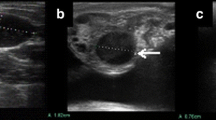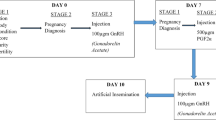Abstract
The objective of this study was to evaluate the fertility of sexed semen compared with conventional semen with regard to the puberty and breeding ages of Holstein dairy heifers subjected to double Ovsynch protocol with fixed time of artificial insemination. A total of 468 Holstein heifers were divided into two groups. The first group was 122 dairy heifers inseminated via conventional semen, while the second group was 346 heifers inseminated with sexed semen. The puberty and breeding ages of heifers were determined from the farm records. Estrus was synchronized using the double Ovsynch protocol. Numbers were estimated for pregnancy at 40 and 60 days post insemination, embryonic loss, and abortion. The results revealed that the heifers inseminated with sexed semen had a significantly lower first-service pregnancy rate (51.45%) than those inseminated with conventional semen (61.47%). Heifers achieving puberty before 350 days old had a higher pregnancy rate. Embryonic losses and abortion rates did not differ between the two types of semen. Holstein heifers subjected to Ovsynch protocol with sexed semen had an acceptable first-insemination pregnancy rate. Even the applications of sexed semen reduce the reproductive fertility and pregnancy rate in Holstein heifers.
Similar content being viewed by others
References
Abdalla, H., Ali, M.A., El-Tarabany, M.S., 2014. Fertility of commercial sexed semen and the economic analyses of its application in Holstein heifers. Adv. Anim. Vet. Sci., 2 (9): 535–542.
An, L., Wu, Z.H., Wu, Y.F., Zhang, X.L., Liu, X., Zhu, Y.B., Cheng, W.M., Gao, H.M., Guo, M., Tian, J.H., 2010. Fertility in single-ovulating and superovulated dairy heifers after insemination with low-dose sex-sorted sperm. Reprod. Dom. Anim., 45: 344–350.
Brusveen, D.J., Cunha, A.P., Silva, C.D., Cunha, P.M., Sterry, R.A., Silva, E.P.B., Guenther, J.N., Wiltbank, M.C., 2008. Altering the time of the second gonadotropin-releasing hormone injection and artificial insemination (AI) during Ovsynch affects pregnancies per AI in lactating dairy cows. J. Dairy Sci., 91(3):1044–1052.
Colazo, M.G., Mapletoft, R.J., 2017. Pregnancy per AI in Holstein heifers inseminated with sex-selected or conventional semen after estrus detection or timed-AI. CVJ, 58: 365–370.
Colazo, M.G., Gordon, M.B., Rajamahendran, R., Mapletoft, R.J., Ambrose, D.J., 2009. Pregnancy rates to timed-AI in dairy cows treated with gonadotropin-releasing hormone or porcine luteinizing hormone. Theriogenology, 72:262–270.
DeJarnette, J.M., Nebel, R.L., Marshall, C.E., 2009. Evaluating the success of sex-sorted semen in US dairy herds from on-farm records. Theriogenology, 71: 49–58.
DeJarnette, J.M., Leach, M.A., Nebel, R.L., Marshall, C.E., McCleary, C.R., Moreno, J.F., 2011. Effects of sex-sorting and sperm dosage on conception rates of Holstein heifers: is comparable fertility of sex-sorted and conventional semen plausible? J. Dairy Sci., 94: 3477–3483.
Dominguez, J.H., Costa, D.S., Centurion, V.J., Faria, F.J., 2011. Pregnancy rate of Nelore females inseminated with male-sexed semen. Anim. Reprod. Sci., 129: 127–131.
Frijters, A.C.J., Mullaart, E., Roelofs, R.M.G., van Hoorne, R.P., Moreno, J.F., Moreno, O., Merton, J.S., 2009. What affects fertility of sexed bull semen more, low sperm dosage or the sorting process? Theriogenology, 71: 64–67.
Gosálvez, J., Ramirez, M.A., López-Fernández, C., Crespo, F., Evans, K.M., Kjelland, M.E., Moreno, J.F., 2011. Sex-sorted bovine spermatozoa and DNA damage: I. Static features. Theriogenology, 75: 197- 205.
Healy, A.A., House, J.K., Thomson, P.C., 2013. Artificial insemination field data on the use of sexed and conventional semen in nulliparous Holstein heifers. J Dairy Sci., 96:1905–1914.
Holden, S.A., Butler, S.T., 2018. Review: Applications and benefits of sexed semen in dairy and beef herds. Animal, 12(1): 97-103. https://doi.org/10.1017/S1751731118000721.
Joezy-Shekalgorabia, S., Maghsoudib, A., Mansourianc, M. R., 2017. Reproductive performance of sexed versus conventional semen in Holstein heifers in various semiarid regions of Iran. Italian Journal of animal science, 16(4):666-672.
Karakaya, E., Yilmazbas-Mecitoglu, G., Keskin, A., Alkan, A., Tasdemir, U., Santos, J.E.P., Gumen, A., 2014. Fertility in dairy cows after artificial insemination using sex-sorted sperm or conventional semen. Reprod. Domest. Anim., 49: 333–337.
Khalajzadeh, S., Nejati-Javaremi, A., Mehrbani Yeganeh, H.M., 2012. Effect of widespread and limited use of sexed semen on genetic progress and reproductive performance of dairy cows. Animal, 6-9: 1398–1406.
Kurykin, J., Jalakas, M., Kaart, T., Jaakma, Ü., 2017. Efficiency of insemination with sexed semen at spontaneous estrus and synchronization of ovulation in lactating Holstein cows. VETERINARIJA IR ZOOTECHNIKA, 75 (96): 22-29.
Lucena J.A., Kenyon A.G., Reynolds J.P., Moreno J.F., Lenz E.W., Carroll D., Lehenbauer T.W., Champagne J.D., Aly S.S., 2014. Comparison between low dose, high-sort, and high-dose, low-sort semen on conception and calf sex ratio in Jersey heifers and cows. J Dairy Sci., 97, 1–8.
Mikkola, M., Andersson, M., Taponen, J., 2015. Transfer of cattle embryos produced with sex-sorted semen results in impaired pregnancy rate and increased male calf mortality. Theriogenology, 84:1118–1122.
National Research Council, 2001. Nutrient requirements of dairy cattle, 7th rev. ed., Washington, DC: The National Academies Press.
Noonan, E.J., Kelly, J.C., Beggs, D.S., 2016. Factors associated with fertility of nulliparous dairy heifers following a 10-day fixed-time artificial insemination program with sex-sorted and conventional semen. Aust Vet J., 94:145–148.
Norman, H.D., Hutchison, J.L., Miller, R.H., 2010. Use of sexed semen and its effect on conception rate, calf sex, dystocia, and stillbirth of Holsteins in the United States. J Dairy Sci., 93:3880–3890.
Oikawa K., Yamazaki T., Yamaguchi S., Abe H., Bai H., Takahashi M., Kawahara M., 2019. Effects of use of conventional and sexed semen on the conception rate in heifers: A comparison study. Theriogenology, 135:33-37. https://doi.org/10.1016/j.theriogenology.2019.06.012.
Seidel, G. E. Jr., 2003. Economics of selecting for sex: The most important genetic trait. Theriogenology, 59: 585–598.
Seidel G. E., Jr., 2014. Update on sexed semen technology in cattle. Animal, 8:160–164.
Seidel, G. E., and Schenk, J. L., 2002. Field trials with sexed, frozen bovine semen. Pages 64–69 in Proc. 19th Tech. Conf. on Artificial Insemination and Reproduction. Natl. Assoc. Animal Breeders, Columbia, MO.
Steinhauser, C.B. Graham, J.K., Lenz, R.W., Seidel, G.E. Jr., 2016. Removing seminal plasma improves bovine sperm sex sorting. Andrology. 4:1131–1137.
Wathes, D.C., Pollott, G.E., Johnson, K.F., Richardson, H., Cooke, J.S., 2014. Heifer fertility and carry over consequences for lifetime production in dairy and beef cattle. Animal, 8 (1):91–104. https://doi.org/10.1017/S1751731114000755.
Acknowledgments
The researchers acknowledge the owner of the dairy farm, Giza, Egypt, for letting us conduct our trials and collect the data. Also, the authors much appreciated the excellent help and efforts of herd veterinarians and the head manager of the farm.
Author information
Authors and Affiliations
Corresponding author
Ethics declarations
Conflict of interest
The authors declare that they have no conflict of interest.
Additional information
Publisher’s note
Springer Nature remains neutral with regard to jurisdictional claims in published maps and institutional affiliations.
Highlights
• The sexed semen with double Ovsynch estrus synchronization protocol could be used to efficiently inseminate nulliparous Holstein heifers with an acceptable first-insemination pregnancy rate.
• The first-insemination pregnancy rate after artificial insemination with sexed semen significantly increased in heifers that had early puberty and breeding ages.
This article belongs to the Topical Collection: Dairy Science and Health in the Tropics
Rights and permissions
About this article
Cite this article
Dawod, A., Elbaz, H.T. Effect of sexed semen, puberty and breeding ages on fertility of Holstein dairy heifers treated with double Ovsynch protocol. Trop Anim Health Prod 52, 2925–2930 (2020). https://doi.org/10.1007/s11250-020-02306-6
Received:
Accepted:
Published:
Issue Date:
DOI: https://doi.org/10.1007/s11250-020-02306-6




